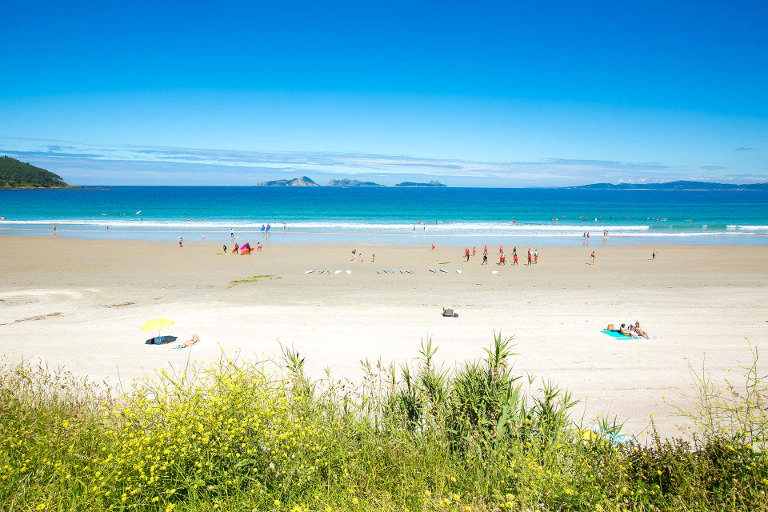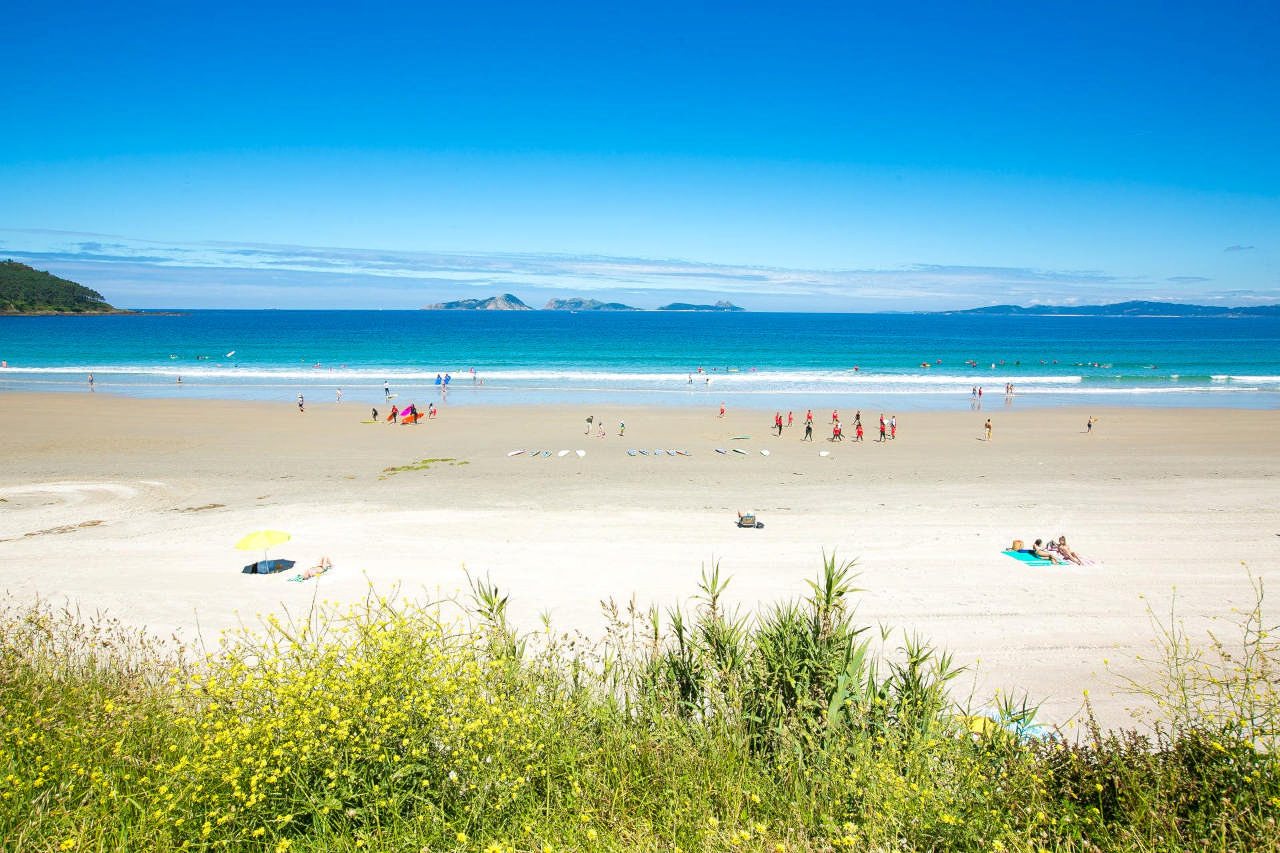Welcome to Galicia
Unspoilt by the style of tourism that is more typical of the Spanish costas, Galicia’s Rías Baix as, the southern fjords of Galicia, offer a benign climate, friendly people, spectacular beaches, a multitude of delightful villages and sweeping valleys of pine and eucalyptus trees.
as, the southern fjords of Galicia, offer a benign climate, friendly people, spectacular beaches, a multitude of delightful villages and sweeping valleys of pine and eucalyptus trees.
Culturally, Galicians relate to Celts, and many ancient Celtic villages have survived. Their Celtic roots are never more evident than in the local fiestas where bagpipes are played and the music and dances performed are not dissimilar to those of Scotland. The population of Galicia is approximately 3 million and an amazing 90% of this number live by, or very close to, the coast or in one of the major cities. The region is known for having a fishing-based economy, but many of these small towns now double up as summer holiday resorts. Agriculture is also a big part of the Galician economy.
The regional cuisine is also unique and highly regarded throughout Spain. Seafood, the peppers from Padrón, and the famous almond tart from Santiago are always featured on the menu, together with the excellent local wines, Ribeiro and Albariño.
Although Santiago, with its wonderful cathedral and many interesting old buildings, should rightly not be missed, the Rias Baixas towns, such as Pontevedra, Cangas and Baiona all offer a glimpse of the real Galicia. If you have a chance to visit inland, you’ll discover why Galicia is known as the land of 1000 rivers. There are many beautiful walks along the banks of the rivers and streams, and several spas in which to spend a relaxing few hours.
Best for…
Best for surfing: Playa de Patos near Nigrán is one of the few beaches in the area which faces directly out to the ocean, and therefore has waves which are higher and rougher than those which line the more protected rias. The beach is about 2km long, and has some excellent views towards the Cies Islands. There is a surf school on the beach which hires out surfing equipment and body boards and they can give lessons for beginners too.
Best outing: Cies Islands- try not to miss a trip to these islands- the Galician Caribbean! On the western side the sea crashes against the rocks and the cliffs take the full brunt of the Atlantic, but on the east a beach of soft, powdery sand is framed by pine trees and the sea is calm and inviting. Although it’s tempting to spend all day on the beach, the islands have several walking routes and, as part of the Atlantic Islands National Park, there are plenty of bird watching opportunities. As the Islands are protected visitors are limited to 2,200 a day so advance booking is necessary either online or at one of the Mar de Ons offices at the ports of Vigo, Cangas or Baiona.
Best quirky visit: In the small fishing village of Combarro close to Poio, the waterfront is lined with quaint cottages which are home to many of the local fishermen. The cottages are often adorned with flowerboxes, and in front of them is a whole row of ‘horreos’, grain stores raised off the ground on stone pillars to prevent mice from entering. However, in Combarro they were used as fish drying sheds. There are about 30 horreos here all lined up in a row along the shore, making this charming little village a unique and interesting place to visit. Also, keeping with the theme of these grain stores, along the road towards Pontevedra is the Monastery of Poio, where you can find the longest horreo in Galicia.
Best for wine lovers: There are several wine routes but the most accessible are the O Salnes route around Sanxenxo which has the largest number of vineyards and wineries in the Rias Baixas and is the heartland of the Albariño wine, and the O Rosal route on the northern banks of the Miño where the mild climate favours Loureira grapes which produce a full-bodied wine with an intense aroma. There are several wine festivals held during the first two weeks of July.
Best beaches for families: For smaller children the smaller beaches of the Morrazo peninsular offer calmer and warmer seas and rock pools to explore. Older children would prefer the larger beaches of Playa America and A Lanzada, where there are pedaloes and other activities available.
Best for tapas: The square of Plaza de la Leña in the old part of Pontevedra used to be the place to go to buy wood- leña is Spanish for firewood. Now though, this delightful little square surrounded by 18th century houses is filled with lively tapas bars selling reasonably priced and freshly cooked portions. Alternatively, wander around the old town of Vigo where several 16th century fishermen’s houses still remain. The Rua Real was once the main street in Vigo and the surrounding small streets open up into squares with lots of tapas bars.
Beaches
The Rias Baixas can claim some of the best beaches in the whole of Spain and the choice ranges from long stretches of sandy beaches to smaller coves backed by dunes and pine forests. Many of the beaches have Blue Flag certification.
Playa de Patos
Halfway between Vigo and Baiona, this beach faces on to open sea and the relatively lively waves make it one of the local surfers’ favourites. The fine, white sand and the view over the Cies Islands appeals to all.
Playa de Rodas
Situated on the rocky Cies Islands with their pronounced cliffs, this beach of soft, white sand gives magnificent views of the estuary and open sea. You can cross by boat to the island from Vigo, Cangas and Baiona.
A Lanzada
An enormous beach with views towards the island of Ons. The side nearest to Sanxenxo is suitable for surfing and there are plenty of cafes and beachside restaurants. It is backed by sand dunes which form part of the protected coastal park.
Playa Canelas
Between Portonovo and Sanxenxo, this Blue Flag beach is 380 metres long, and is one of the most popular with those seeking a beach with good facilities. There are umbrellas, sunbeds and showers here and lots of activities available on and around the beach. Good for lively youngsters.
Playa America
A firm favourite with holidaymakers thanks to its magnificent views over the Cies Islands, as well as its many facilities and activities.
Fiestas
There are many, many fiestas in the province of Pontevedra during the summer months, from the small local village fiestas to the large celebrations which take a whole year to organise. Here are some of the most impressive, of ‘special touristic interest’, which are well worth a visit.
Corpus Christi- Variable dates between end of May and mid June
The town of Ponteareas celebrates Corpus Christi by covering the streets with spectacular carpets of flowers which adorn the path of the Holy Sacrament. It is an impressive spectacle both for its sheer size and colour. This traditional festival dates back to 1857, when the streets of Ponteareas were strewn with herbs and scented flowers to line the route taken by the religious procession. The floral carpet is the result of a whole night’s work in which the whole town is involved.
The festival was declared to be of Touristic Interest in 1968 and then became officially recognised as of National Touristic Interest in 1980. Thousands of visitors come to see these floral carpets spread over several thousand metres. Ponteareas is now twinned with the town of La Orotava in the Canary Islands where these Corpus Christi carpets are also made.
Rapa das Bestas in Sabucedo (La Estrada)- First weekend in July
This fiesta dates back to the 15th century and is held every year during the first weekend of July. Young men from the surrounding area head for the mountains at dawn to find the wild horses that live there. The aim is to bring them back to the village and cut their manes in what is considered to be a noble confrontation between man and horse. At the end of the day, all come together to celebrate with food, wine and music. The hills where all this takes place are dotted with prehistoric drawings which represent astral symbols, animals and show scenes of hunting and the taming of animals.
Fiesta del Marisco de O Grove- Second Sunday in October
Widely acclaimed as the place to find the best seafood in Europe, the annual O Grove Seafood Festival attracts more than 220,000 people every year. The programme of events is in fact spread over the first and second week of October during which one of the features is ‘Feiramar’, one of Europe’s most established seafood trade events, and fiestas dedicated to turbot and mussels. This is undoubtedly the best place to sample the best flavours and textures the sea can produce- clams, oysters, lobsters, langoustine, scallops- and to discover what a goose barnacle and sea spider really taste like! Besides the copious tasty morsels available, there are many supporting activities including sculpture exhibitions, folk dance and music, and displays of live seafood.
Explore the towns and villages of Galicia
Collectively known as the ‘Rias Baixas’, the fjord-like river estuaries of the southern corner of Galicia have carved a picturesque coastline that boasts an abundance of sheltered beaches of fine golden sand.
Pontevedra
The charming city of Pontevedra sits at the foot of the Ria de Vigo estuary and the town centre is a delightful maze of narrow alleyways, cobbled streets and stone flagged squares. At the heart of this historical quarter is the Praza da Peregrina, a smart pedestrianised square where stands the tall twin-towered 18th century Virgin La Peregrina church, which is built in the shape of a scallop to house a statue of the city’s patroness. Pontevedra is the capital town of the province of the same name and it is the only city in Galicia that has a bullring, the tradition of bull fighting still being very strong here.
Baiona
Visit the chic harbour town of Baiona, which has a strong history associating it with the New World. It was the first port in Europe to receive the news of the discovery of America. Visit the tapas bars in the old town, the medieval Castillo de Monterreal (now the parador) and the replica of the Caraval Pinta, the ship that brought the news of the discovery of America.
Cies Islands
During the summer months, a frequent ferry service operates from the port of Vigo to the Cies Islands. These three islands lie at the entrance of the Ria de Vigo and boast some superb beaches of golden sand, backed by a beautifully unspoilt area of Natural Park. In July and August there are also ferry services from Baiona and Cangas to the islands.
A Guarda
A Guarda, the most southern fishing port of Galicia, has an attractive port overlooked by colourful fishing houses. It is particularly famous for its lobster dishes, which are renowned throughout the Rias Baixas. A Guardians love their summer festivals, so you are likely to come across at least one during your visit. The Groba Mountains rise up from A Guarda and the area is sparsely populated. The hills themselves offer beautiful walks in wooded countryside and it is not unusual to see wild horses grazing on the hillsides.
Sanxenxo
Sanxenxo is a larger centre and boasts some long sandy beaches that are bordered by a promenade and numerous cafes and restaurants. Whilst id does become busy in July and August, the visitors are mainly Spanish and the town has a very local atmosphere. Views across the waters encompass the islands of Ons and Cies on a clear day and ferries operate from the port of Sanxenxo to Ons.
O Grove
O Grove is the seafood capital of Galicia. Centuries ago, the town was an island but it is now joined to the mainland and at its southern end a bridge of half a kilometre connects it to the pretty island of A Toxa.
Santiago de Compostela
No visitor can leave Galicia without witnessing the spectacular heritage of Santiago de Compostela, the focal point for pilgrims who travel from all over the world to pay homage to St James the Apostle. The story goes that St James the Apostle came to Galicia to preach but meeting with no success, returned to Palestine, where he was martyred. When King Herod denied him a burial, his followers stole his body, took it to a beach and happened upon an empty marble boat. There being no sailors, an angel guided the vessel to Arousa Bay on the western shores of Galicia and up the River Ulla to Padron. From here, a cart pulled by two wild bulls took the body to the Santiago area. It disappeared without trace until a monk discovered it in 813 AD. Miracles ensued, word spread and pilgrims from all over Europe begun to establish the famous Ways to Santiago, that for the first time brought people of different nations together in peace.
Vigo
The bustling town of Vigo is the second largest fishing port in the world. Visit the old part of town which lies behind the port and is filled with cobbled streets, where fresh fish is sold in the morning market. Wander along the Rua do Pescaderia to see a fine array of fresh oysters being sold, this being the local speciality. Choose your own live oysters from the ladies selling them on stalls in the street, and they will then open them for you. Then enjoy them with a glass of Albarino from one of the bars opposite.
Galician Gastronomy
Galicia is well known throughout Spain for the quality of its food. The calm waters of the estuaries are the source of some of the finest seafood in the country and people have been known to travel from Madrid to eat in restaurants in Galicia.
Many of the bars and restaurants serve the food in the form of ‘tapas’ or ‘raciones’, which are small portions of food. Tapas are smaller than raciones and the typical way to eat these is to ask for a number of different dishes and share them. Most menus feature ‘empanada’, which is a light pastry normally filled with cockles (empanada de berberecho) or tuna fish (empanada de atun), Ostras (oysters) and mejillones (mussels) are very typical and their freshness must be tasted to be believed. Also worth trying are ‘conchas’ or scallops, which are served in their shells with a delicious mixture of finely chopped peppers and onions.
Meat is also very well presented. A hearty local dish that is often seen on menus is ‘cocido’, meat served in large portions together with boiled potatoes and vegetables. This dish is often eaten in the winter months and the juices from the meat are extracted to produce ‘caldo’, a delicious starter of meat juices with a few potatoes and vegetables. The most typical dessert is ‘tarta de Santiago’, which is a light almond cake served with a sprinkling of icing sugar on the top. To accompany these dishes, try the deliciously fruity white Albarino wine, which is produced in the area near the estuaries, or the lighter Ribeiro, from the region of Ourense.
Fire Water
You may occasionally see a waiter in your restaurant setting fire to a large bowl of liquid for a group celebrating a special occasion. This is the traditional ‘Queimada’. There are many myths and mysteries surrounding the ritual of making Queimada, the ‘fire drink’ of Galicia, which is thought to have originated in ancient times when Celts established villages and settled in the region of Galicia. The process includes a ritual where the Queimada maker recites a ‘spell’ as he makes the drink. Although the Queimada is made with orujo, a strong liqueur typical of the north of Spain, much of the alcohol is burned off in the flames.


















